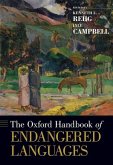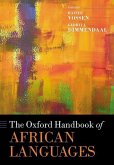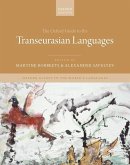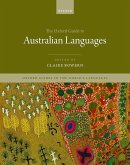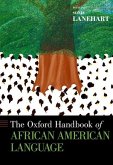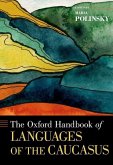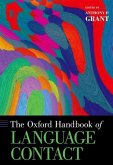Oxford Guide to the Languages of the Central Andes
Herausgeber: Urban, Matthias
Oxford Guide to the Languages of the Central Andes
Herausgeber: Urban, Matthias
- Gebundenes Buch
- Merkliste
- Auf die Merkliste
- Bewerten Bewerten
- Teilen
- Produkt teilen
- Produkterinnerung
- Produkterinnerung
This volume presents the first comprehensive overview in English of the languages of the Central Andes, spoken primarily in Peru and Bolivia. Chapters provide detailed descriptions of individual languages and substantial typological comparative analyses, as well as coverage of language history, language contact, and sociolinguistics.
Andere Kunden interessierten sich auch für
![Oxford Handbook of Endangered Languages Oxford Handbook of Endangered Languages]() Oxford Handbook of Endangered Languages258,99 €
Oxford Handbook of Endangered Languages258,99 €![The Oxford Handbook of African Languages The Oxford Handbook of African Languages]() The Oxford Handbook of African Languages299,99 €
The Oxford Handbook of African Languages299,99 €![The Oxford Guide to the Transeurasian Languages The Oxford Guide to the Transeurasian Languages]() The Oxford Guide to the Transeurasian Languages281,99 €
The Oxford Guide to the Transeurasian Languages281,99 €![The Oxford Guide to Australian Languages The Oxford Guide to Australian Languages]() The Oxford Guide to Australian Languages228,99 €
The Oxford Guide to Australian Languages228,99 €![Oxford Handbook of African American Language Oxford Handbook of African American Language]() Oxford Handbook of African American Language274,99 €
Oxford Handbook of African American Language274,99 €![The Oxford Handbook of Languages of the Caucasus The Oxford Handbook of Languages of the Caucasus]() The Oxford Handbook of Languages of the Caucasus281,99 €
The Oxford Handbook of Languages of the Caucasus281,99 €![The Oxford Handbook of Language Contact The Oxford Handbook of Language Contact]() The Oxford Handbook of Language Contact258,99 €
The Oxford Handbook of Language Contact258,99 €-
-
-
This volume presents the first comprehensive overview in English of the languages of the Central Andes, spoken primarily in Peru and Bolivia. Chapters provide detailed descriptions of individual languages and substantial typological comparative analyses, as well as coverage of language history, language contact, and sociolinguistics.
Hinweis: Dieser Artikel kann nur an eine deutsche Lieferadresse ausgeliefert werden.
Hinweis: Dieser Artikel kann nur an eine deutsche Lieferadresse ausgeliefert werden.
Produktdetails
- Produktdetails
- Verlag: Oxford University Press
- Seitenzahl: 1008
- Erscheinungstermin: 9. Oktober 2024
- Englisch
- ISBN-13: 9780198849926
- ISBN-10: 0198849923
- Artikelnr.: 71264863
- Herstellerkennzeichnung
- Produktsicherheitsverantwortliche/r
- Europaallee 1
- 36244 Bad Hersfeld
- gpsr@libri.de
- Verlag: Oxford University Press
- Seitenzahl: 1008
- Erscheinungstermin: 9. Oktober 2024
- Englisch
- ISBN-13: 9780198849926
- ISBN-10: 0198849923
- Artikelnr.: 71264863
- Herstellerkennzeichnung
- Produktsicherheitsverantwortliche/r
- Europaallee 1
- 36244 Bad Hersfeld
- gpsr@libri.de
Matthias Urban is Researcher at the CNRS laboratory "Dynamique du language", where he directs an ERC project on historical dynamics in language geography. He has held prior appointments at the Max Planck Institute for Evolutionary Anthropology in Leipzig and the universities of Leiden, Marburg, and Tübingen, where he was principal investigator of the Junior Research Group "The Language Dynamics of the Ancient Central Andes," hosted by the University of Tübingen and funded by the German Research Foundation (DFG)'s Emmy Noether Programme. His research interests include historical linguistics, in particular of the Andes, language contact, and linguistic typology.
* Part I. Background and context
* 1: Matthias Urban: Introduction: Central Andean linguistic diversity
and the diversity of Central Andean linguistics
* 2: Peter Kaulicke: Physical geography and cultural trajectory of the
Central Andes
* 3: Rodolfo Cerrón-Palomino: Historical linguistics, philology, and
the development of Andean linguistics
* Part II. Language profiles
* 4: Carlos Molina-Vital: Huaylas (Ancash) Quechua
* 5: Aviva Shimelman: Southern Yauyos Quechua
* 6: Aviva Shimelman and Jairo Valqui: Chachapoyas Quechua
* 7: Raúl Bendezú Araujo and Jorge Acurio-Palma: Cuzco Quechua
* 8: Matt Coler: Aymara
* 9: Matt Coler: Jaqaru
* 10: Katja Hannß: Uru and Chipaya
* 11: Matthias Urban: Mochica
* 12: Nicholas Q. Emlen, Willem F. H. Adelaar, Simon van de Kerke, and
Arjan Mossel: Puquina
* 13: Astrid Alexander-Bakkerus: Hibito and Cholón
* 14: Matthias Urban: Small and extinct languages of Northern Peru
* 15: Pieter Muysken: Kallawaya
* 16: Luis Andrade Ciudad: The Andean Spanish of Southern Peru and
Bolivia
* Part III. Comparative studies
* 17: Lev Michael and Allegra Robertson: Central Andean segmental
phonologies in continental perspective
* 18: Olga Krasnoukhova: The morphology of the nominal domain in the
languages of the Central Andes
* 19: Matthias Pache: The grammar of the verb in the languages of the
Central Andes
* 20: Rik van Gijn: Syntactic structures in the languages of the
Central Andes
* 21: Karolina Grzech: Discourse, information structure, and
evidentiality in the Central Andes
* 22: Johanna Nichols: Linguistic complexity in the Central Andes
* Part IV. Language history
* 23: Paul Heggarty: Expansions and language shift in prehistory
* 24: Matthias Urban: Language ecologies and dynamics in the ancient
Central Andes
* 25: César Itier: Language diffusion and state agency: Quechuan in
Inca and colonial times
* Part V. Language contact, sociolinguistics, and linguistic
anthropology
* 26: Nicholas Q. Emlen: The Quechuan-Aymaran relationship
* 27: Anna María Escobar: Contact between indigenous languages of the
Central Andes and Spanish: Linguistic outcomes as cases of
contra-hierarchical diffusion
* 28: Rosaleen Howard: Language ideologies and the Quechuan family
* 29: Nicholas Q. Emlen, Rik van Gijn, and Sietze Norder: The
Andean-Amazonian interface: Sociolinguistic relations and
areal-typological patterns
* 30: Joshua Shapero: Language and the Andean environment
* 1: Matthias Urban: Introduction: Central Andean linguistic diversity
and the diversity of Central Andean linguistics
* 2: Peter Kaulicke: Physical geography and cultural trajectory of the
Central Andes
* 3: Rodolfo Cerrón-Palomino: Historical linguistics, philology, and
the development of Andean linguistics
* Part II. Language profiles
* 4: Carlos Molina-Vital: Huaylas (Ancash) Quechua
* 5: Aviva Shimelman: Southern Yauyos Quechua
* 6: Aviva Shimelman and Jairo Valqui: Chachapoyas Quechua
* 7: Raúl Bendezú Araujo and Jorge Acurio-Palma: Cuzco Quechua
* 8: Matt Coler: Aymara
* 9: Matt Coler: Jaqaru
* 10: Katja Hannß: Uru and Chipaya
* 11: Matthias Urban: Mochica
* 12: Nicholas Q. Emlen, Willem F. H. Adelaar, Simon van de Kerke, and
Arjan Mossel: Puquina
* 13: Astrid Alexander-Bakkerus: Hibito and Cholón
* 14: Matthias Urban: Small and extinct languages of Northern Peru
* 15: Pieter Muysken: Kallawaya
* 16: Luis Andrade Ciudad: The Andean Spanish of Southern Peru and
Bolivia
* Part III. Comparative studies
* 17: Lev Michael and Allegra Robertson: Central Andean segmental
phonologies in continental perspective
* 18: Olga Krasnoukhova: The morphology of the nominal domain in the
languages of the Central Andes
* 19: Matthias Pache: The grammar of the verb in the languages of the
Central Andes
* 20: Rik van Gijn: Syntactic structures in the languages of the
Central Andes
* 21: Karolina Grzech: Discourse, information structure, and
evidentiality in the Central Andes
* 22: Johanna Nichols: Linguistic complexity in the Central Andes
* Part IV. Language history
* 23: Paul Heggarty: Expansions and language shift in prehistory
* 24: Matthias Urban: Language ecologies and dynamics in the ancient
Central Andes
* 25: César Itier: Language diffusion and state agency: Quechuan in
Inca and colonial times
* Part V. Language contact, sociolinguistics, and linguistic
anthropology
* 26: Nicholas Q. Emlen: The Quechuan-Aymaran relationship
* 27: Anna María Escobar: Contact between indigenous languages of the
Central Andes and Spanish: Linguistic outcomes as cases of
contra-hierarchical diffusion
* 28: Rosaleen Howard: Language ideologies and the Quechuan family
* 29: Nicholas Q. Emlen, Rik van Gijn, and Sietze Norder: The
Andean-Amazonian interface: Sociolinguistic relations and
areal-typological patterns
* 30: Joshua Shapero: Language and the Andean environment
* Part I. Background and context
* 1: Matthias Urban: Introduction: Central Andean linguistic diversity
and the diversity of Central Andean linguistics
* 2: Peter Kaulicke: Physical geography and cultural trajectory of the
Central Andes
* 3: Rodolfo Cerrón-Palomino: Historical linguistics, philology, and
the development of Andean linguistics
* Part II. Language profiles
* 4: Carlos Molina-Vital: Huaylas (Ancash) Quechua
* 5: Aviva Shimelman: Southern Yauyos Quechua
* 6: Aviva Shimelman and Jairo Valqui: Chachapoyas Quechua
* 7: Raúl Bendezú Araujo and Jorge Acurio-Palma: Cuzco Quechua
* 8: Matt Coler: Aymara
* 9: Matt Coler: Jaqaru
* 10: Katja Hannß: Uru and Chipaya
* 11: Matthias Urban: Mochica
* 12: Nicholas Q. Emlen, Willem F. H. Adelaar, Simon van de Kerke, and
Arjan Mossel: Puquina
* 13: Astrid Alexander-Bakkerus: Hibito and Cholón
* 14: Matthias Urban: Small and extinct languages of Northern Peru
* 15: Pieter Muysken: Kallawaya
* 16: Luis Andrade Ciudad: The Andean Spanish of Southern Peru and
Bolivia
* Part III. Comparative studies
* 17: Lev Michael and Allegra Robertson: Central Andean segmental
phonologies in continental perspective
* 18: Olga Krasnoukhova: The morphology of the nominal domain in the
languages of the Central Andes
* 19: Matthias Pache: The grammar of the verb in the languages of the
Central Andes
* 20: Rik van Gijn: Syntactic structures in the languages of the
Central Andes
* 21: Karolina Grzech: Discourse, information structure, and
evidentiality in the Central Andes
* 22: Johanna Nichols: Linguistic complexity in the Central Andes
* Part IV. Language history
* 23: Paul Heggarty: Expansions and language shift in prehistory
* 24: Matthias Urban: Language ecologies and dynamics in the ancient
Central Andes
* 25: César Itier: Language diffusion and state agency: Quechuan in
Inca and colonial times
* Part V. Language contact, sociolinguistics, and linguistic
anthropology
* 26: Nicholas Q. Emlen: The Quechuan-Aymaran relationship
* 27: Anna María Escobar: Contact between indigenous languages of the
Central Andes and Spanish: Linguistic outcomes as cases of
contra-hierarchical diffusion
* 28: Rosaleen Howard: Language ideologies and the Quechuan family
* 29: Nicholas Q. Emlen, Rik van Gijn, and Sietze Norder: The
Andean-Amazonian interface: Sociolinguistic relations and
areal-typological patterns
* 30: Joshua Shapero: Language and the Andean environment
* 1: Matthias Urban: Introduction: Central Andean linguistic diversity
and the diversity of Central Andean linguistics
* 2: Peter Kaulicke: Physical geography and cultural trajectory of the
Central Andes
* 3: Rodolfo Cerrón-Palomino: Historical linguistics, philology, and
the development of Andean linguistics
* Part II. Language profiles
* 4: Carlos Molina-Vital: Huaylas (Ancash) Quechua
* 5: Aviva Shimelman: Southern Yauyos Quechua
* 6: Aviva Shimelman and Jairo Valqui: Chachapoyas Quechua
* 7: Raúl Bendezú Araujo and Jorge Acurio-Palma: Cuzco Quechua
* 8: Matt Coler: Aymara
* 9: Matt Coler: Jaqaru
* 10: Katja Hannß: Uru and Chipaya
* 11: Matthias Urban: Mochica
* 12: Nicholas Q. Emlen, Willem F. H. Adelaar, Simon van de Kerke, and
Arjan Mossel: Puquina
* 13: Astrid Alexander-Bakkerus: Hibito and Cholón
* 14: Matthias Urban: Small and extinct languages of Northern Peru
* 15: Pieter Muysken: Kallawaya
* 16: Luis Andrade Ciudad: The Andean Spanish of Southern Peru and
Bolivia
* Part III. Comparative studies
* 17: Lev Michael and Allegra Robertson: Central Andean segmental
phonologies in continental perspective
* 18: Olga Krasnoukhova: The morphology of the nominal domain in the
languages of the Central Andes
* 19: Matthias Pache: The grammar of the verb in the languages of the
Central Andes
* 20: Rik van Gijn: Syntactic structures in the languages of the
Central Andes
* 21: Karolina Grzech: Discourse, information structure, and
evidentiality in the Central Andes
* 22: Johanna Nichols: Linguistic complexity in the Central Andes
* Part IV. Language history
* 23: Paul Heggarty: Expansions and language shift in prehistory
* 24: Matthias Urban: Language ecologies and dynamics in the ancient
Central Andes
* 25: César Itier: Language diffusion and state agency: Quechuan in
Inca and colonial times
* Part V. Language contact, sociolinguistics, and linguistic
anthropology
* 26: Nicholas Q. Emlen: The Quechuan-Aymaran relationship
* 27: Anna María Escobar: Contact between indigenous languages of the
Central Andes and Spanish: Linguistic outcomes as cases of
contra-hierarchical diffusion
* 28: Rosaleen Howard: Language ideologies and the Quechuan family
* 29: Nicholas Q. Emlen, Rik van Gijn, and Sietze Norder: The
Andean-Amazonian interface: Sociolinguistic relations and
areal-typological patterns
* 30: Joshua Shapero: Language and the Andean environment


